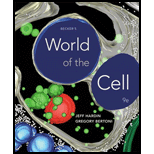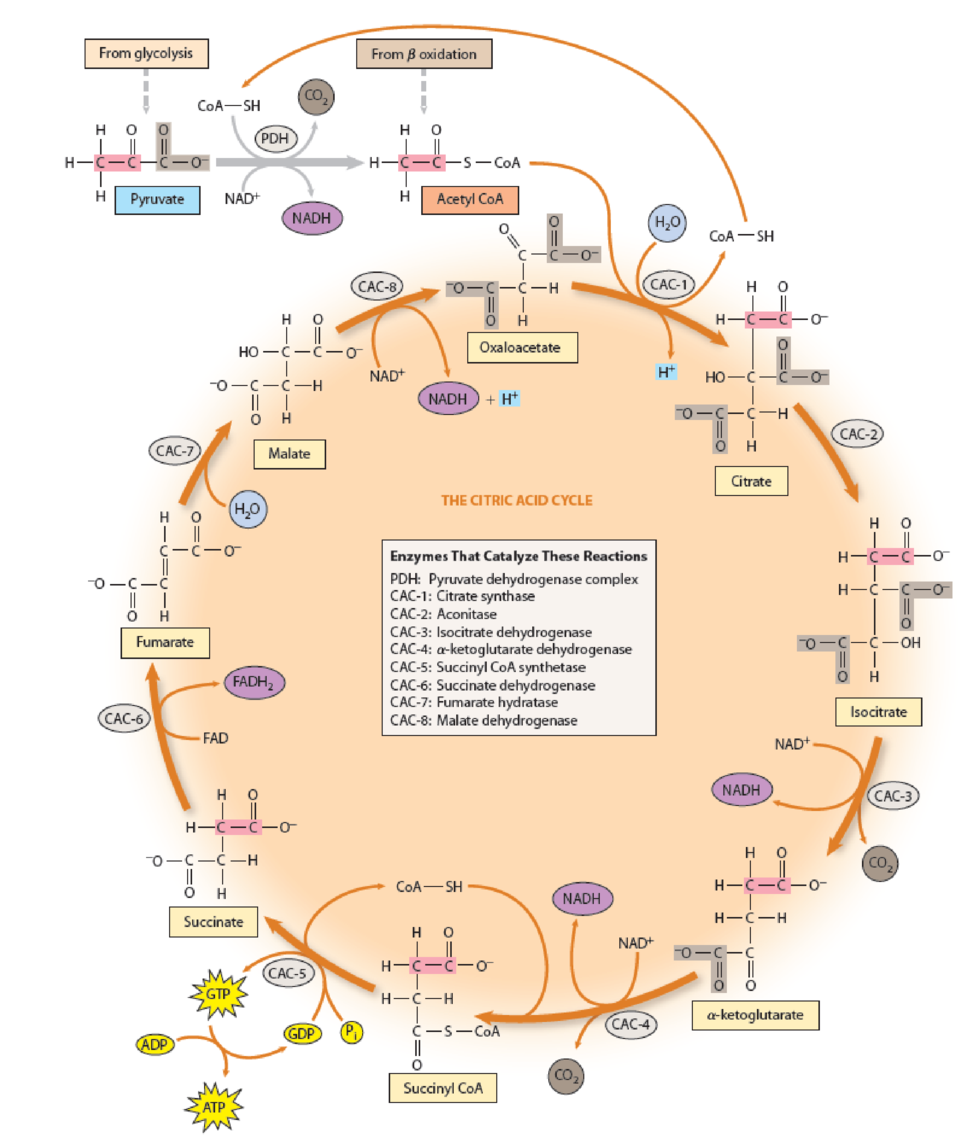
Concept explainers
Problem Set
QUANTITATIVE Succinate Oxidation. The oxidation of succinate to fumarate is an important cellular reaction because it is one of the steps in the citric acid cycle (see Figure 10-9). The two hydrogen atoms that are removed from succinate are accepted by a coenzyme molecule called flavin adenine dinucleotide (FAD), which is thereby reduced to FADH2:
ΔG°′ for Reaction 5-32 is 0 cal/mol.
(a) If you start with a solution containing 0.01 M each of succinate and FAD and add an appropriate amount of the enzyme that catalyzes this reaction, will any fumarate be formed? If so, calculate the resulting equilibrium concentrations of all four species. If not, explain why not.
(b) Answer part a assuming that 0.01 M FADH2 is also present initially.
(c) If the steady-state conditions in a cell are such that the FADH2/FAD ratio is 5 and the fumarate concentration is 2.5 μM, what steady-state concentration of succinate is needed to maintain ΔG′ for succinate oxidation at –1.5 kcal/mol?

Figure 10-9 The Citric Acid Cycle. The two carbon atoms of pyruvate that enter the cycle via acetyl CoA are shown in pink in citrate and subsequent molecules until they are randomized by the symmetry of the fumarate molecule. The carboxyl group of pyruvate that is lost as CO2 is shaded, as are the two carboxyl groups of oxaloacetate that give rise to CO2 in reactions CAC-3 and CAC-4. Five of the reactions are oxidations, with NAD+ as the electron acceptor in four reactions (PDH, CAC-3, CAC-4, and CAC-8) and FAD as the electron acceptor in one reaction (CAC-6). The reduced form of the coenzyme is shown in purple in each case. Note that when CO2 is released, no H+ is given off during NAD+ reduction, thereby maintaining the charge balance of these reactions. The generation of GTP shown in reaction CAC-5 is characteristic of animal mitochondria. In bacterial cells and plant mitochondria, ATP is formed directly.
Want to see the full answer?
Check out a sample textbook solution
Chapter 5 Solutions
Becker's World of the Cell (9th Edition)
- When using the concept of "a calorie in is equal to a calorie out" how important is the quality of the calories?arrow_forwardWhat did the Cre-lox system used in the Kikuchi et al. 2010 heart regeneration experiment allow researchers to investigate? What was the purpose of the cmlc2 promoter? What is CreER and why was it used in this experiment? If constitutively active Cre was driven by the cmlc2 promoter, rather than an inducible CreER system, what color would you expect new cardiomyocytes in the regenerated area to be no matter what? Why?arrow_forwardWhat kind of organ size regulation is occurring when you graft multiple organs into a mouse and the graft weight stays the same?arrow_forward
- What is the concept "calories consumed must equal calories burned" in regrads to nutrition?arrow_forwardYou intend to insert patched dominant negative DNA into the left half of the neural tube of a chick. 1) Which side of the neural tube would you put the positive electrode to ensure that the DNA ends up on the left side? 2) What would be the internal (within the embryo) control for this experiment? 3) How can you be sure that the electroporation method itself is not impacting the embryo? 4) What would you do to ensure that the electroporation is working? How can you tell?arrow_forwardDescribe a method to document the diffusion path and gradient of Sonic Hedgehog through the chicken embryo. If modifying the protein, what is one thing you have to consider in regards to maintaining the protein’s function?arrow_forward
- The following table is from Kumar et. al. Highly Selective Dopamine D3 Receptor (DR) Antagonists and Partial Agonists Based on Eticlopride and the D3R Crystal Structure: New Leads for Opioid Dependence Treatment. J. Med Chem 2016.arrow_forwardThe following figure is from Caterina et al. The capsaicin receptor: a heat activated ion channel in the pain pathway. Nature, 1997. Black boxes indicate capsaicin, white circles indicate resinferatoxin. You are a chef in a fancy new science-themed restaurant. You have a recipe that calls for 1 teaspoon of resinferatoxin, but you feel uncomfortable serving foods with "toxins" in them. How much capsaicin could you substitute instead?arrow_forwardWhat protein is necessary for packaging acetylcholine into synaptic vesicles?arrow_forward
- 1. Match each vocabulary term to its best descriptor A. affinity B. efficacy C. inert D. mimic E. how drugs move through body F. how drugs bind Kd Bmax Agonist Antagonist Pharmacokinetics Pharmacodynamicsarrow_forward50 mg dose of a drug is given orally to a patient. The bioavailability of the drug is 0.2. What is the volume of distribution of the drug if the plasma concentration is 1 mg/L? Be sure to provide units.arrow_forwardDetermine Kd and Bmax from the following Scatchard plot. Make sure to include units.arrow_forward
 BiochemistryBiochemistryISBN:9781305577206Author:Reginald H. Garrett, Charles M. GrishamPublisher:Cengage Learning
BiochemistryBiochemistryISBN:9781305577206Author:Reginald H. Garrett, Charles M. GrishamPublisher:Cengage Learning BiochemistryBiochemistryISBN:9781305961135Author:Mary K. Campbell, Shawn O. Farrell, Owen M. McDougalPublisher:Cengage Learning
BiochemistryBiochemistryISBN:9781305961135Author:Mary K. Campbell, Shawn O. Farrell, Owen M. McDougalPublisher:Cengage Learning Biology 2eBiologyISBN:9781947172517Author:Matthew Douglas, Jung Choi, Mary Ann ClarkPublisher:OpenStax
Biology 2eBiologyISBN:9781947172517Author:Matthew Douglas, Jung Choi, Mary Ann ClarkPublisher:OpenStax


